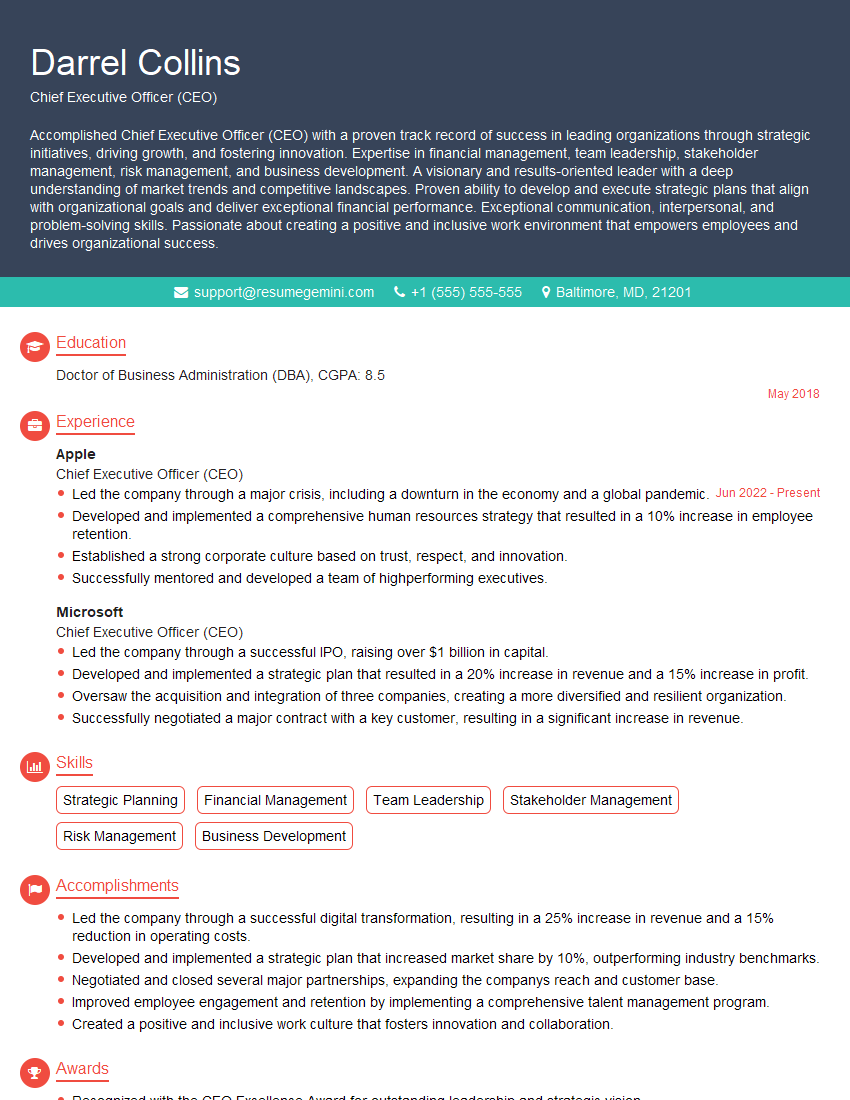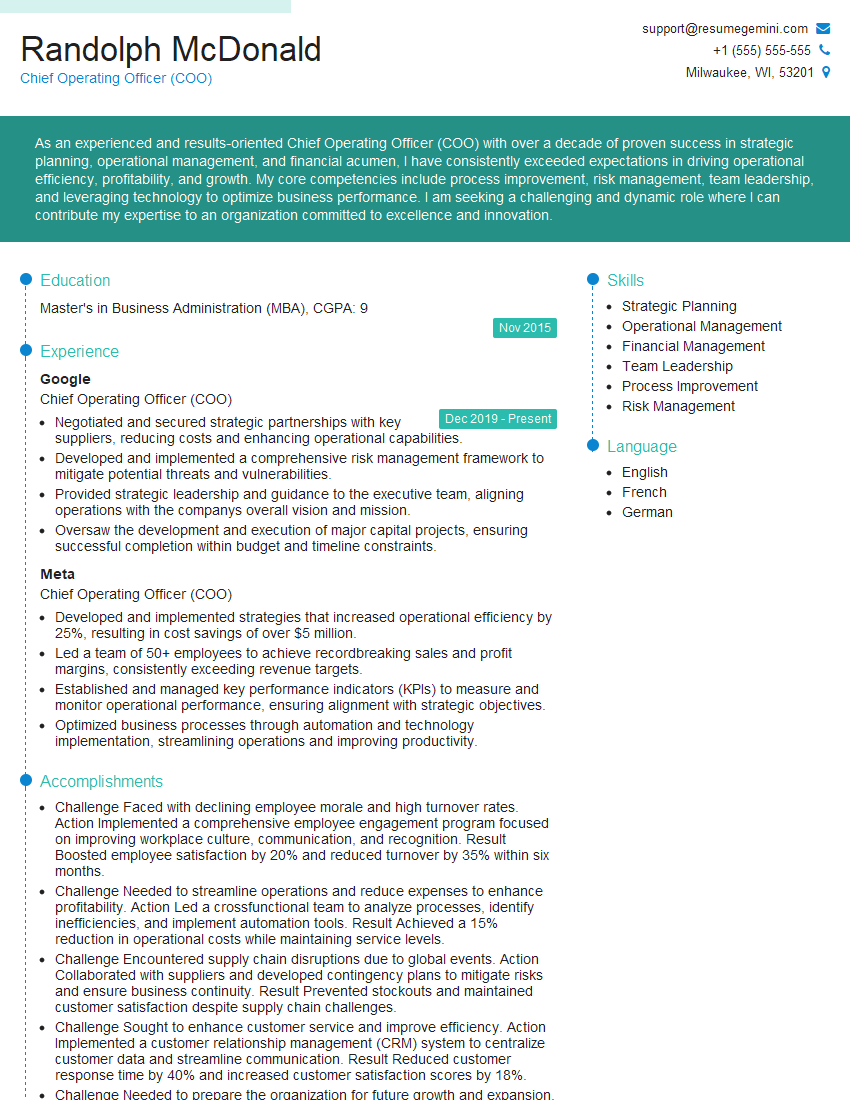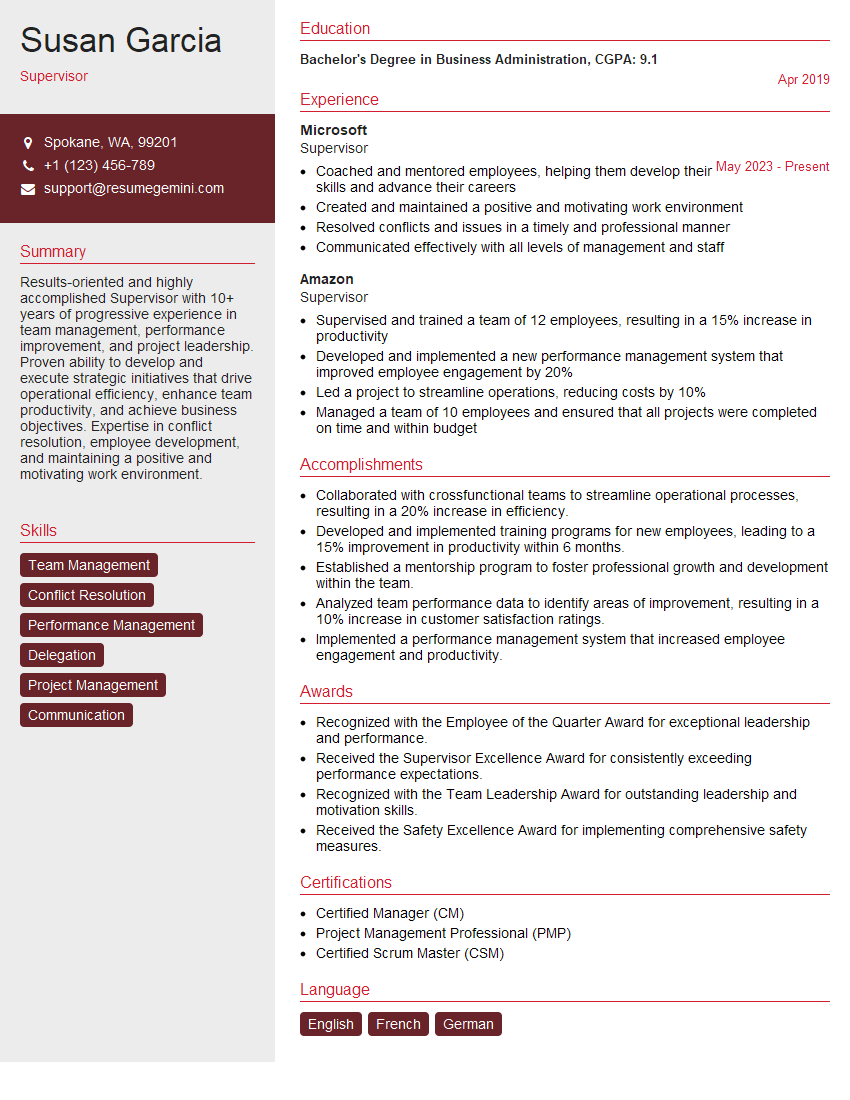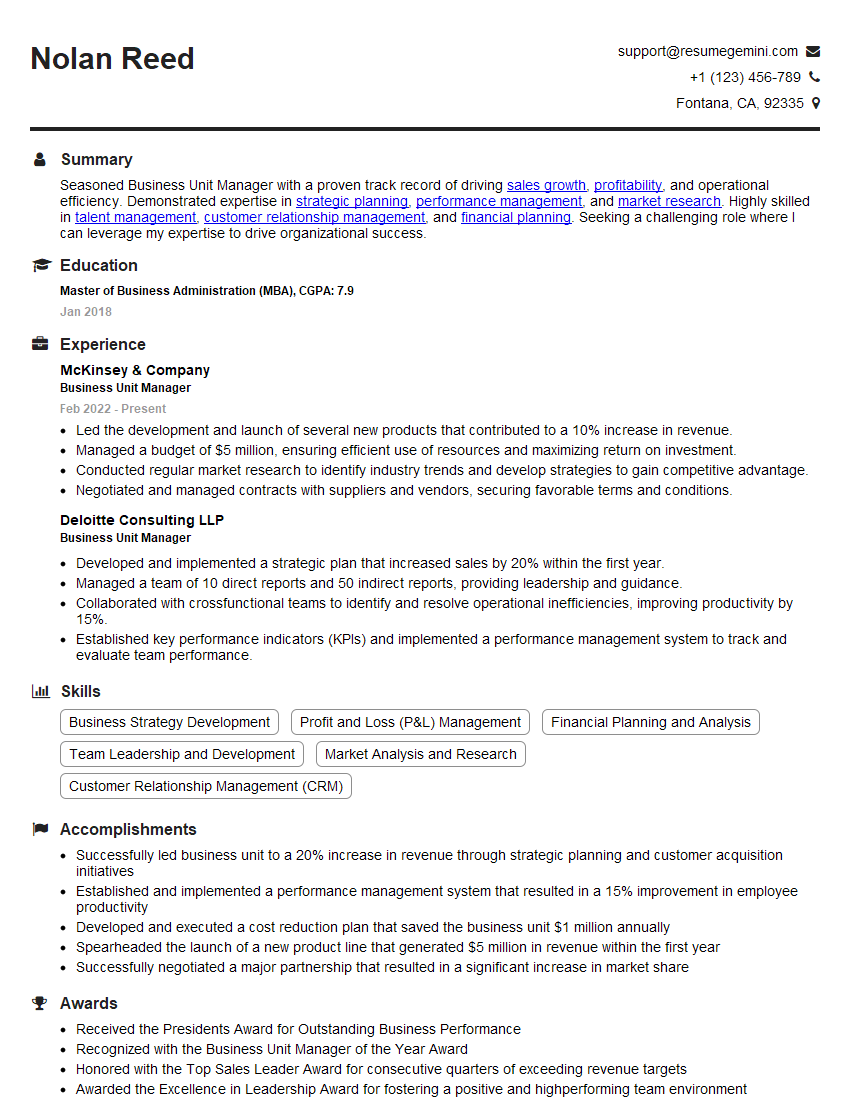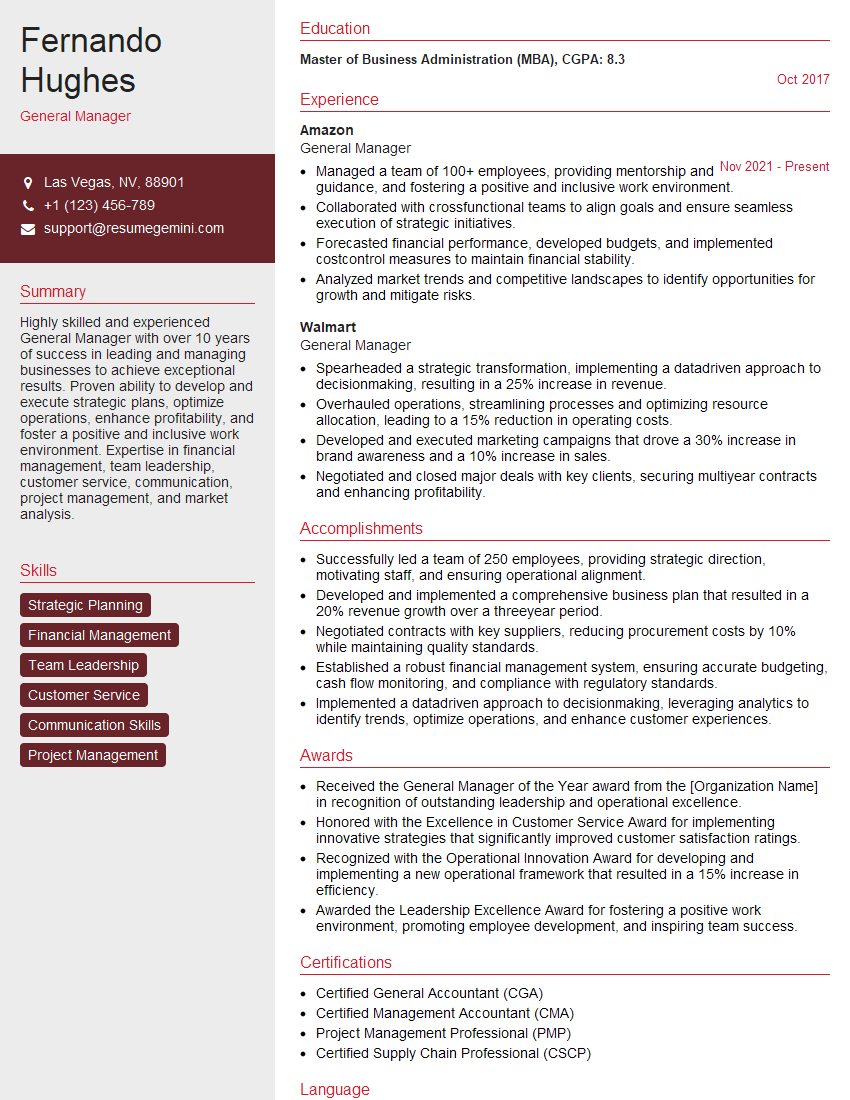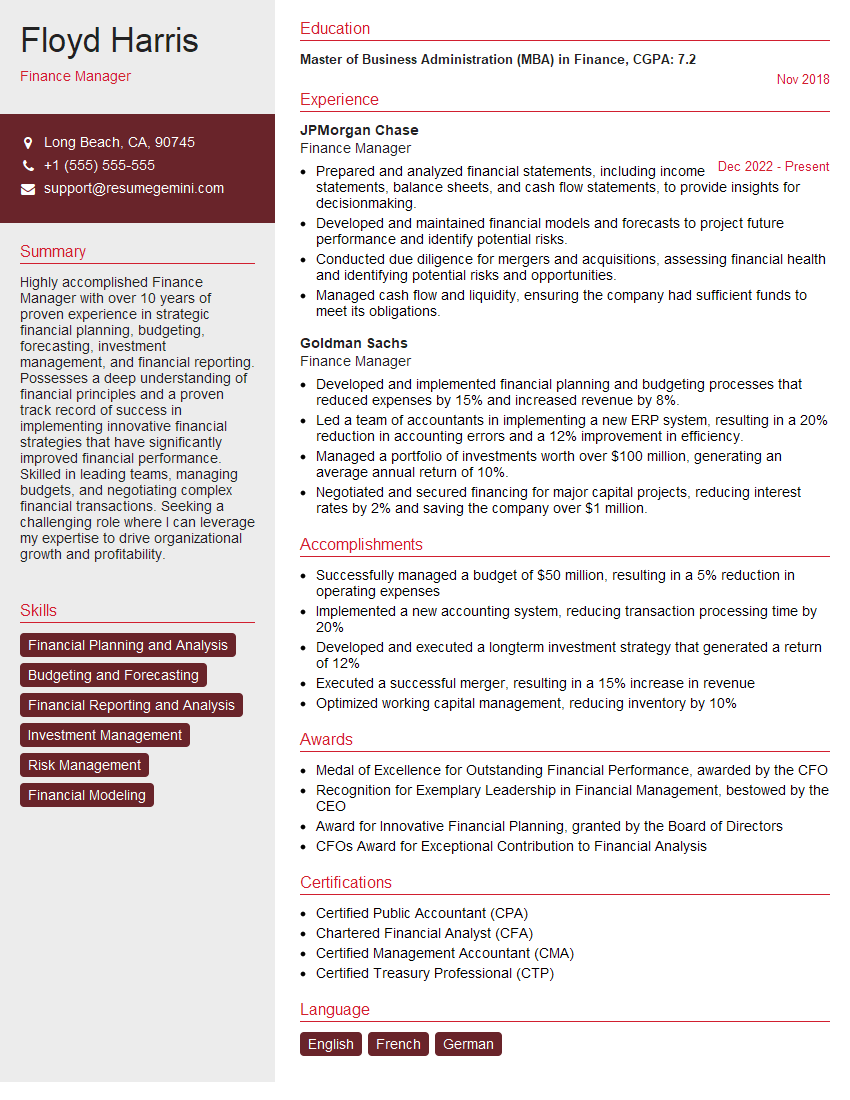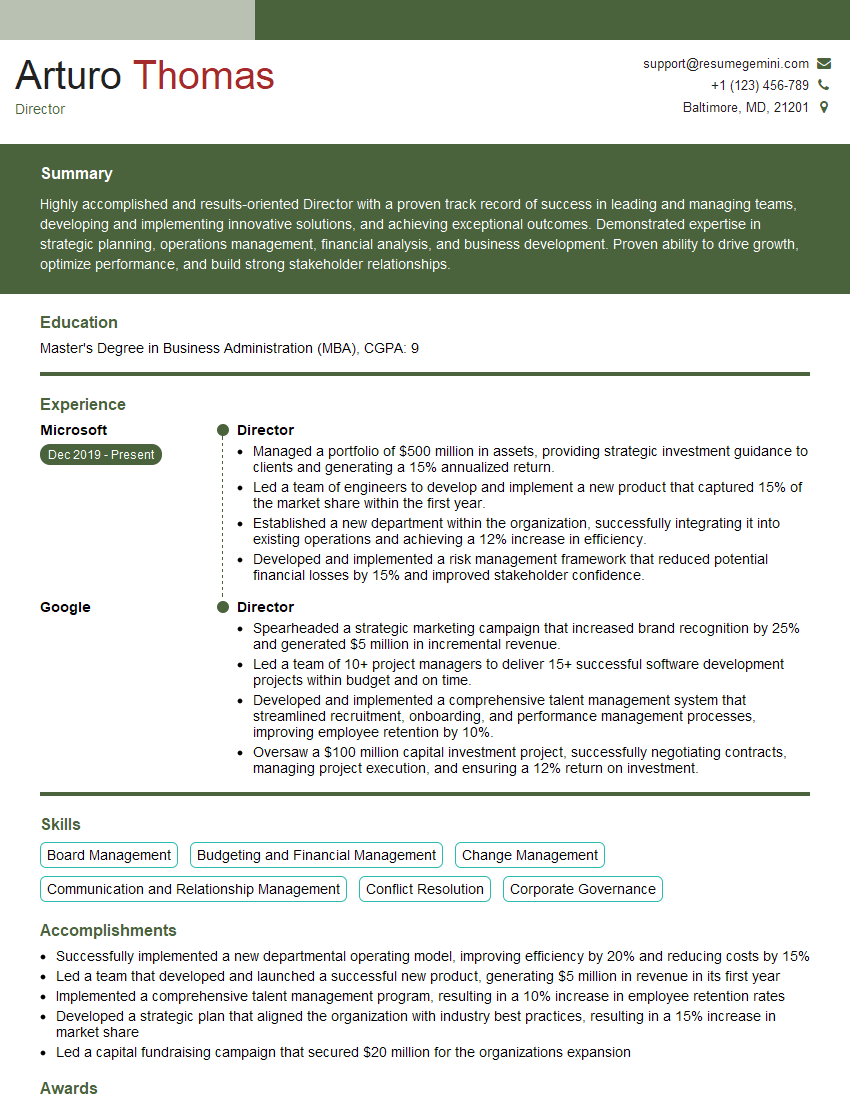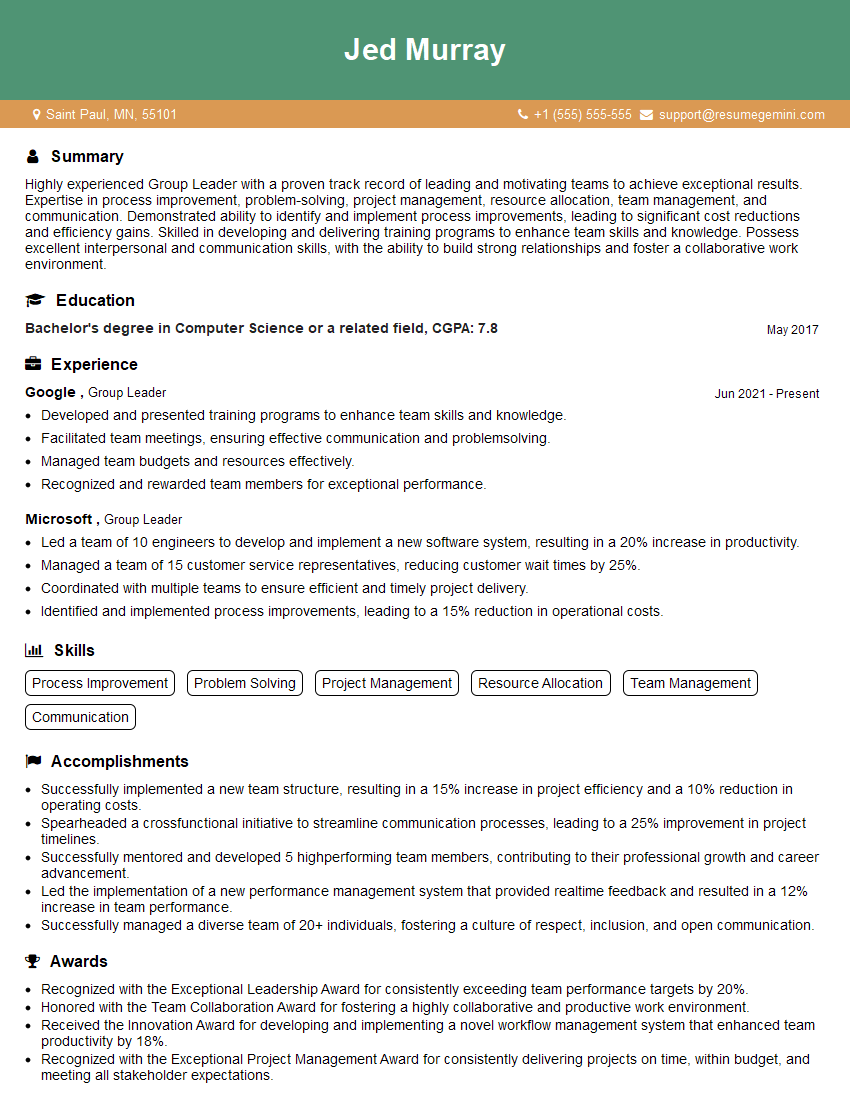Feeling uncertain about what to expect in your upcoming interview? We’ve got you covered! This blog highlights the most important Leadership and Teamwork Skills interview questions and provides actionable advice to help you stand out as the ideal candidate. Let’s pave the way for your success.
Questions Asked in Leadership and Teamwork Skills Interview
Q 1. Describe your leadership style and how it adapts to different team dynamics.
My leadership style is best described as transformational, focusing on inspiring and motivating my team to achieve shared goals. I believe in empowering individuals and fostering a collaborative environment. However, my approach is adaptable. With a highly skilled and independent team, I might adopt a more laissez-faire approach, providing guidance and support as needed, rather than micromanaging. Conversely, with a newer team requiring more structure, I shift to a more directive style, providing clear instructions and close mentorship initially, gradually transitioning to greater autonomy as the team develops confidence and competence.
For instance, in a previous project with a team of experienced developers, I primarily focused on setting the overall vision and objectives, providing resources, and addressing roadblocks. They were comfortable with self-management and thrived in that environment. In contrast, with a junior marketing team, I structured tasks more explicitly, provided regular check-ins, and offered personalized feedback to ensure they grasped the concepts and deliverables.
Q 2. How do you motivate team members to achieve ambitious goals?
Motivating a team to achieve ambitious goals involves understanding individual motivations and creating a compelling shared vision. I achieve this through several strategies:
- Clear Communication and Vision: Articulating a clear, concise vision, highlighting the impact of their work, and its connection to the larger organizational goals.
- Recognition and Appreciation: Regularly acknowledging and celebrating successes, both big and small. Public acknowledgement builds morale and fosters a positive work environment.
- Empowerment and Autonomy: Giving team members ownership over their tasks and fostering a sense of responsibility. This encourages initiative and engagement.
- Growth and Development: Providing opportunities for skill enhancement, including training and mentorship, shows investment in their future and motivates them to contribute more effectively.
- Open Communication and Feedback: Creating a safe space where team members feel comfortable expressing their ideas, concerns, and challenges. Regular feedback sessions help maintain transparency and address roadblocks promptly.
For example, during a challenging project, I publicly acknowledged the team’s dedication and resilience during a particularly difficult phase. This boosted morale significantly, and we successfully completed the project ahead of schedule.
Q 3. Explain a time you had to resolve a conflict within a team.
In a previous project, two team members had a significant disagreement about the best approach to a key feature. This threatened to derail the project timeline. I addressed the conflict using a structured approach:
- Active Listening: I facilitated a meeting where each member had the opportunity to explain their perspective without interruption. This helped identify the root causes of the conflict – differing interpretations of project requirements.
- Identifying Common Ground: I helped them identify shared goals and objectives, focusing on the project’s overall success rather than individual preferences.
- Collaborative Problem-Solving: I guided them in brainstorming alternative solutions that incorporated elements from both approaches. This fostered a sense of shared ownership and responsibility.
- Mediation and Compromise: I helped them reach a compromise that incorporated the best aspects of both proposals. This involved clear communication and a willingness to negotiate.
- Follow-up and Monitoring: After implementing the agreed-upon solution, I followed up with both team members to ensure the issue was resolved and that the new approach was working effectively.
The result was a stronger working relationship between the two team members and a more robust solution for the feature.
Q 4. How do you delegate tasks effectively and ensure accountability?
Effective delegation involves matching tasks to individual skills and capacities, while ensuring clear communication and accountability. I follow these steps:
- Assessment: I carefully assess each team member’s strengths, weaknesses, and workload before assigning tasks. The right person for the job is key.
- Clear Instructions: I provide clear and concise instructions, outlining expectations, deadlines, and deliverables. Ambiguity is the enemy of efficiency.
- Resource Allocation: I ensure that team members have the necessary resources, including tools, information, and support, to complete their tasks effectively.
- Regular Check-ins: I schedule regular check-ins to monitor progress, address any challenges, and provide support as needed. This is proactive problem-solving.
- Accountability Mechanisms: I use project management tools to track progress and ensure accountability. This might involve setting milestones, regular reporting, or progress meetings.
For example, in a previous marketing campaign, I delegated tasks based on individual strengths: one team member focused on social media, another on email marketing, and so on. This division of labor leveraged their unique skills and maximized efficiency.
Q 5. Describe your approach to providing constructive feedback to team members.
Constructive feedback focuses on specific behaviors and their impact, rather than personality traits. I follow the SBI (Situation-Behavior-Impact) model:
- Situation: I describe the specific situation or context in which the behavior occurred. The more detail, the better.
- Behavior: I describe the specific behavior observed, using objective and observable terms. Avoid generalizations.
- Impact: I explain the impact of the behavior, both positive and negative, on the team, the project, or the individual.
I always aim to frame feedback in a supportive and encouraging manner, focusing on improvement and growth. For example, instead of saying “You’re disorganized,” I might say, “In the recent project, I noticed that some deadlines were missed. This impacted the overall project timeline. Let’s discuss strategies for better time management.”
Q 6. How do you build consensus among team members with diverse perspectives?
Building consensus among diverse perspectives requires active listening, respectful communication, and a collaborative approach. I often utilize these strategies:
- Active Listening: I encourage each team member to fully express their viewpoints, actively listening and seeking clarification when necessary.
- Identifying Common Ground: I help the team identify shared goals and underlying values, highlighting areas of agreement.
- Brainstorming and Collaboration: I facilitate brainstorming sessions to generate a range of ideas and solutions, encouraging creative thinking and collaboration.
- Compromise and Negotiation: I guide the team toward finding solutions that address the needs and concerns of all stakeholders, involving compromise and negotiation.
- Decision-Making Process: I employ a clear decision-making process that is transparent and fair to all members, ensuring that all voices are heard and considered.
For example, when deciding on a new marketing strategy, I facilitated a series of workshops where team members from different departments shared their insights and concerns. Through collaborative brainstorming and negotiation, we reached a consensus on a plan that incorporated the best aspects of all the proposals.
Q 7. How do you handle disagreements or conflicts within a team?
Disagreements and conflicts are inevitable in any team. My approach is to address them directly and constructively, focusing on resolving the issue rather than assigning blame. I typically follow these steps:
- Identify the Issue: Clearly define the nature of the disagreement or conflict, ensuring everyone understands the problem.
- Facilitate Open Communication: Create a safe space for all involved to express their perspectives without interruption or judgment.
- Focus on Solutions: Shift the focus from assigning blame to finding collaborative solutions that address the root cause of the conflict.
- Mediation and Negotiation: Act as a neutral mediator, helping team members find common ground and reach a mutually acceptable solution.
- Document Agreement: Once a solution is reached, document the agreement clearly to avoid future misunderstandings.
- Follow-up and Monitoring: Monitor the implementation of the solution and address any recurring issues promptly.
It’s crucial to remember that disagreements don’t necessarily signal failure. They often highlight different perspectives and can lead to innovative solutions if managed effectively.
Q 8. How do you measure the success of a team project?
Measuring the success of a team project goes beyond simply achieving the stated goal. It involves a holistic assessment considering various factors. A truly successful project delivers on its objectives, but also strengthens team dynamics and fosters individual growth.
- Objective Achievement: Did the team meet the project goals (scope, quality, time, budget)? This is measured through clearly defined Key Performance Indicators (KPIs) set at the project’s outset. For example, if the project aimed to increase website traffic by 20%, we’d measure the actual increase against that target.
- Process Efficiency: Did the team work effectively? Were there efficient workflows, effective communication, and minimal roadblocks? This might be assessed through feedback surveys, project retrospectives, or analysis of project management tools.
- Team Dynamics: Did the project enhance team cohesion and collaboration? Was there mutual respect, effective conflict resolution, and a positive working environment? This could be evaluated through team surveys, observation, and informal feedback from team members.
- Individual Growth: Did team members learn new skills or develop existing ones? This is often assessed through performance reviews, individual feedback sessions, and observation of skill application in future projects. For instance, did junior team members improve their coding skills or did senior members refine their leadership approaches?
- Stakeholder Satisfaction: Were the clients or stakeholders satisfied with the end result and the project process? This is usually measured through feedback forms, client meetings, or surveys.
In essence, a successful project is one that accomplishes its goals while simultaneously building a stronger, more capable team.
Q 9. Describe a time you had to make a difficult decision that impacted your team.
In a previous role, our team faced a significant budget shortfall halfway through a large-scale software development project. Several features were at risk of being cut, leading to potential delays and dissatisfaction from our client. The decision I had to make was whether to cut features or to renegotiate the scope with the client, potentially impacting our project timeline and profitability.
After careful deliberation, considering the impact on both the client and my team’s morale, I opted for a combination of strategies. First, we prioritized the essential features, eliminating less critical ones. Second, I facilitated a transparent conversation with the client, explaining our financial constraints and proposing a revised scope. Fortunately, they understood the situation and were willing to collaborate, accepting a slightly delayed project timeline.
While this decision was difficult, it fostered transparency and trust with the client, prevented drastic cuts that would have negatively impacted the project quality, and protected the team’s morale by involving them in the problem-solving process.
Q 10. How do you foster a positive and collaborative team environment?
Fostering a positive and collaborative team environment is crucial for success. It requires a proactive and multifaceted approach, focusing on communication, trust, mutual respect, and a shared sense of purpose.
- Open Communication: Establishing regular, transparent communication channels is key. This includes team meetings, project updates, individual check-ins, and readily available feedback mechanisms.
- Trust and Respect: Creating a culture of trust and respect means valuing each team member’s contributions, recognizing their efforts, and providing constructive feedback. This fosters psychological safety, allowing team members to take risks and openly express their ideas.
- Shared Goals: Ensuring everyone understands the project’s goals and how their individual roles contribute to the overall success is important. This alignment fosters a sense of shared ownership and responsibility.
- Collaboration Tools: Utilizing collaboration tools (project management software, communication platforms, shared document repositories) streamlines workflows and enhances communication efficiency.
- Team Building Activities: Occasional team-building activities can help improve team cohesion and build stronger relationships. These can range from informal social gatherings to more structured problem-solving exercises.
- Conflict Resolution: Establishing clear guidelines for conflict resolution and providing training on conflict management techniques are essential to address issues constructively.
The goal is to create a workspace where everyone feels valued, heard, and empowered to contribute their best.
Q 11. How do you identify and utilize the strengths of individual team members?
Identifying and utilizing individual strengths is a cornerstone of effective team leadership. It involves a systematic process of understanding team members’ skills, preferences, and motivations.
- Assessments: Using personality assessments (like Myers-Briggs or StrengthsFinder) or skills inventories can provide valuable insights into individual strengths. However, these tools should be used in conjunction with observations and discussions.
- Observation and Feedback: Observing team members in action and gathering feedback from both themselves and peers helps reveal their strengths and areas for development. Paying attention to what tasks individuals excel at and enjoy is critical.
- Open Communication: Regular one-on-one conversations allow leaders to better understand individual aspirations and preferences, helping match them with suitable roles and responsibilities. This helps ensure team members feel valued and engaged.
- Delegation: Strategically delegating tasks based on individual strengths ensures high-quality output and develops team members’ capabilities. This shows trust in their abilities and fosters ownership.
- Mentoring: Supporting team members in developing their strengths through mentorship and training opportunities helps maximize their potential.
By leveraging individual strengths, teams become more productive, innovative, and engaged.
Q 12. Explain your experience with mentoring or coaching team members.
I have extensive experience mentoring and coaching team members, focusing on both skill development and career progression. My approach is tailored to the individual’s needs and learning style. I often use a combination of techniques, including:
- One-on-One Coaching: Regular meetings focused on setting goals, identifying challenges, and providing constructive feedback and support.
- Mentorship: Sharing my experience and expertise to guide team members in their career development, helping them navigate challenges and make informed decisions.
- Skill-Specific Training: Identifying skill gaps and providing access to training materials, workshops, or external resources to help team members enhance their capabilities.
- Feedback and Recognition: Providing regular and specific feedback, celebrating successes, and recognizing efforts to motivate and encourage continued growth.
- Delegation with Support: Assigning challenging tasks to foster growth while providing guidance and support to ensure success.
For example, I mentored a junior developer who lacked confidence in their coding abilities. Through regular coaching sessions, I provided constructive feedback, helped them break down complex tasks, and celebrated their small victories. This approach significantly improved their skills and self-confidence, leading to improved performance and greater contributions to the team.
Q 13. How do you address underperforming team members?
Addressing underperformance requires a careful and sensitive approach, focusing on understanding the root cause and providing support and guidance. It’s crucial to avoid jumping to conclusions and to focus on solutions rather than blame.
- Identify the Issue: Conduct a thorough assessment of the underperformance, considering factors such as lack of training, unclear expectations, lack of resources, or personal issues. This might involve reviewing their work, speaking with colleagues, and conducting a performance review.
- Open Communication: Have a private and frank conversation with the team member, expressing your concerns while remaining supportive and focusing on solutions. Actively listen to their perspective and address any concerns they might have.
- Set Clear Expectations: Ensure that the team member understands their responsibilities, performance expectations, and the consequences of continued underperformance. This should involve clear, measurable, achievable, relevant, and time-bound (SMART) goals.
- Provide Support and Resources: Offer the necessary resources, training, or mentoring to help them improve. This could involve providing additional training, assigning a mentor, or adjusting their workload.
- Performance Improvement Plan (PIP): If the underperformance persists despite support, a formal Performance Improvement Plan may be necessary. This plan outlines specific goals, timelines, and support measures, with regular check-ins to track progress.
- Consequences: If the team member fails to meet the expectations outlined in the PIP, disciplinary action, up to and including termination, may be necessary.
The goal is to help the team member improve their performance while maintaining a fair and supportive work environment.
Q 14. Describe a time you had to adapt your leadership style to a challenging situation.
During a period of significant organizational restructuring, our team faced uncertainty and decreased morale. My usual leadership style, which is collaborative and empowering, needed adjustment to navigate this challenging situation. I initially relied heavily on open communication and collaboration, but I realized that the uncertainty required a more directive approach.
I shifted to a more structured, task-oriented leadership style, providing clear direction and setting realistic expectations. I increased the frequency of communication, offering consistent updates and reassurance about the organizational changes and their impact on the team. I also focused on celebrating small wins and acknowledging team members’ resilience in the face of adversity.
This adapted style helped maintain team focus and morale during a turbulent period. Once the restructuring stabilized, I gradually transitioned back to my collaborative style, ensuring that the team felt involved in shaping the future direction.
This experience underscored the importance of adapting one’s leadership style to meet the demands of specific circumstances. The ability to flexibly navigate various leadership approaches is vital for success in dynamic environments.
Q 15. How do you handle pressure and stress when leading a team?
Leading a team often involves navigating high-pressure situations. My approach is multifaceted. Firstly, I prioritize my own well-being; stress management techniques like regular exercise, mindfulness, and sufficient sleep are crucial. This ensures I can effectively support my team. Secondly, I foster a culture of open communication where team members feel comfortable expressing concerns and challenges. This proactive approach prevents minor issues from escalating into major crises. Thirdly, I break down large, daunting tasks into smaller, more manageable chunks. This makes the overall project less overwhelming and allows for regular progress checks, mitigating potential stress points. For example, during a particularly demanding product launch, we divided the project into distinct phases with clearly defined milestones and regular team meetings to monitor progress and address concerns promptly. This strategy reduced overall pressure and improved team morale.
Career Expert Tips:
- Ace those interviews! Prepare effectively by reviewing the Top 50 Most Common Interview Questions on ResumeGemini.
- Navigate your job search with confidence! Explore a wide range of Career Tips on ResumeGemini. Learn about common challenges and recommendations to overcome them.
- Craft the perfect resume! Master the Art of Resume Writing with ResumeGemini’s guide. Showcase your unique qualifications and achievements effectively.
- Don’t miss out on holiday savings! Build your dream resume with ResumeGemini’s ATS optimized templates.
Q 16. How do you prioritize tasks and manage deadlines within a team setting?
Prioritization and deadline management are key to efficient teamwork. I use a combination of techniques, including the Eisenhower Matrix (urgent/important), to categorize tasks. This helps us focus on high-impact, time-sensitive tasks first. We then use project management tools like Trello or Asana to visually track progress, deadlines, and individual responsibilities. Regular team meetings, both short daily stand-ups and more in-depth weekly progress reviews, help maintain momentum and address any roadblocks promptly. Transparency is vital; everyone understands the priorities and deadlines, fostering accountability and collaboration. For instance, during a website redesign project, we used a Kanban board in Asana to visually map out tasks, their status, and assigned team members. This provided a shared understanding of the workflow and helped manage the tight deadlines effectively.
Q 17. How do you ensure that all team members are aligned on project goals and objectives?
Aligning a team requires clear communication and shared understanding. I begin by clearly articulating the project goals and objectives, ensuring everyone understands the ‘why’ behind the project. This is followed by a collaborative process of defining key performance indicators (KPIs) and success metrics. These metrics become the shared benchmarks for progress. Regular team meetings, coupled with detailed project documentation, ensure consistent understanding. I also actively encourage questions and feedback to clarify any misunderstandings. For example, in a marketing campaign, we started with a detailed kickoff meeting outlining the target audience, campaign goals (increased brand awareness, lead generation), and the key metrics we’d track (website traffic, social media engagement, lead conversion rates). This ensured everyone was on the same page from the beginning.
Q 18. How do you handle situations where team members are not meeting expectations?
Addressing underperformance requires a sensitive yet firm approach. My first step is a private conversation with the team member to understand the root cause. Is it a lack of skills, unclear expectations, lack of resources, or personal challenges? Once the issue is identified, we collaboratively develop an action plan with clear, achievable goals and timelines. This plan might involve additional training, mentorship, or adjustments to their workload. Consistent monitoring and regular check-ins are vital to support the team member and track progress. If the situation doesn’t improve despite these interventions, further steps, in line with company policy, might be necessary. It’s important to remember that addressing underperformance is not about blame but about supporting the individual and ensuring team success. For example, when a team member consistently missed deadlines, we discovered it was due to an overwhelming workload. We redistributed tasks, provided additional training on time management, and implemented regular check-in meetings. This resulted in significant improvement in their performance.
Q 19. Describe your experience with managing remote or virtual teams.
I have extensive experience managing remote and virtual teams. Effective communication is paramount. I rely heavily on asynchronous communication tools like Slack and email for updates and project discussions, supplemented by regular video conferencing for team meetings and individual check-ins. Establishing clear communication protocols, including response times and preferred communication channels, is vital. Building trust and rapport within a virtual team requires intentional effort; I encourage virtual coffee breaks or informal online interactions to foster a sense of community and belonging. For example, while leading a software development team spread across three different time zones, we used a combination of daily stand-up meetings (via video conferencing) and asynchronous updates via Slack. This allowed for flexibility, catered to different time zones and maintained consistent communication.
Q 20. How do you use technology and tools to enhance team collaboration?
Technology is a crucial enabler of team collaboration. We utilize project management software (Trello, Asana, Jira) for task assignment, progress tracking, and deadline management. Communication platforms like Slack and Microsoft Teams facilitate seamless information sharing and quick responses. Video conferencing tools (Zoom, Google Meet) are essential for team meetings and individual interactions. Document sharing platforms (Google Drive, SharePoint) ensure everyone has access to the latest information. The choice of tools depends on project specifics and team preferences, but the core principle remains consistent: using technology to improve efficiency, communication, and collaboration. For instance, during a large-scale data analysis project, we used Jira to manage tasks, Google Drive for document sharing, and Zoom for regular progress meetings. This streamlined the entire process and ensured efficient collaboration.
Q 21. How do you foster open communication within a team?
Fostering open communication is fundamental to effective teamwork. I actively encourage a culture of psychological safety where team members feel comfortable expressing their opinions, concerns, and ideas, without fear of judgment. This involves setting clear expectations for respectful communication, actively listening to team members, valuing diverse perspectives, and providing constructive feedback. Regular team meetings, both formal and informal, provide opportunities for open dialogue. I also use anonymous feedback mechanisms occasionally to gather honest insights. Transparency in decision-making processes, explaining the reasoning behind choices, helps build trust and understanding. For example, we implemented a weekly ‘feedback Friday’ session where team members could share any thoughts or concerns, fostering open communication and addressing issues proactively.
Q 22. Describe a time you had to deal with a challenging team member.
Dealing with challenging team members requires a balanced approach combining empathy, clear communication, and firm action. It’s crucial to understand the root cause of the challenge – is it a skill gap, personality clash, or something else? My approach involves:
- Understanding the individual: I begin by having a private conversation, focusing on listening actively to their perspective and concerns. This helps me understand their motivations and challenges.
- Setting clear expectations: Once I understand the situation, I clearly articulate expectations for behaviour and performance, ensuring they are aligned with team goals. This includes providing specific examples and consequences if expectations are not met.
- Offering support and guidance: If the challenge stems from a skill gap, I offer training, mentorship, or resources to help the individual improve. If it’s a personality clash, I might facilitate mediation or encourage collaboration.
- Taking firm action if necessary: If the behaviour persists despite my efforts, I will escalate the issue to management, following company protocols. This is a last resort, but necessary to maintain a healthy team environment.
For example, I once had a team member who consistently missed deadlines. After several private conversations revealing stress from a personal matter, I adjusted their workload, provided additional support, and worked with them to establish a more manageable schedule. This collaborative approach resulted in improved performance and a stronger working relationship.
Q 23. How do you manage competing priorities within a team?
Managing competing priorities within a team requires a strategic and collaborative approach. It’s not about doing everything at once but prioritizing effectively and ensuring everyone is aligned. I utilize a few key strategies:
- Prioritization Framework: We use a prioritization matrix (like Eisenhower Matrix – Urgent/Important) to assess tasks, ensuring that the most critical items are addressed first.
- Open Communication: Regular team meetings and clear communication channels are crucial to keep everyone informed about priorities and potential roadblocks. We use tools like project management software to track progress and identify bottlenecks.
- Delegation and Empowerment: I delegate tasks based on team members’ skills and expertise, empowering them to take ownership and responsibility. This fosters a sense of ownership and reduces my workload.
- Timeboxing and Realistic Goals: We set realistic deadlines and allocate specific time blocks for each task to prevent overwhelm and ensure focus. This includes building in buffer time for unforeseen challenges.
- Regular Review and Adjustment: We regularly review our progress, assess the impact of completed tasks, and adjust priorities as needed based on new information or changing circumstances.
For instance, in a previous project, we were facing several urgent deadlines across different modules. By utilizing the Eisenhower Matrix and clearly communicating priorities, the team effectively managed the workload and met all critical deadlines.
Q 24. How do you build trust and rapport with your team members?
Building trust and rapport is fundamental to effective teamwork. It’s about creating a safe and inclusive environment where team members feel valued and respected. My approach involves:
- Active Listening and Empathy: I make a conscious effort to listen actively to my team members, understanding their perspectives and concerns. Showing empathy builds connections and strengthens relationships.
- Transparency and Open Communication: I promote open communication, sharing information transparently and honestly, even when delivering difficult news. This fosters trust and avoids misunderstandings.
- Vulnerability and Authenticity: I strive to be authentic and vulnerable when appropriate, sharing my own experiences and challenges. This humanizes me and allows for stronger connections.
- Recognition and Appreciation: Regularly acknowledging individual contributions and celebrating team successes strengthens relationships and fosters a sense of belonging.
- Consistent Actions: Maintaining consistent behavior, being reliable and keeping commitments builds trust over time. Actions speak louder than words.
For example, I regularly hold one-on-one meetings with team members to discuss their progress, challenges, and career aspirations. This shows my interest in their well-being and strengthens our professional relationships.
Q 25. Explain your approach to facilitating effective team meetings.
Facilitating effective team meetings requires careful planning and execution. The goal is to maximize productivity and ensure everyone feels heard and engaged. My approach includes:
- Clear Agenda and Objectives: I always begin by setting a clear agenda with specific objectives, distributing it in advance to allow preparation.
- Time Management: I adhere to the allotted time for each agenda item to ensure efficiency and prevent meetings from dragging on.
- Active Participation and Inclusivity: I create an inclusive environment, encouraging everyone to participate and share their ideas. I actively manage discussions to prevent dominance by a few individuals.
- Actionable Outcomes: Each meeting should result in clear action items, assigned responsibilities, and deadlines. These are documented and distributed after the meeting.
- Regular Follow-Up: I follow up on action items after the meeting to ensure progress and address any roadblocks.
For instance, I use visual aids like whiteboards or shared documents to facilitate discussions and keep track of action items. I also encourage the use of collaborative tools to enhance meeting efficiency.
Q 26. How do you measure your own leadership effectiveness?
Measuring leadership effectiveness is an ongoing process, not a one-time event. I use a multi-faceted approach to assess my performance:
- Team Performance: I measure team productivity, project success rates, and overall goal attainment. This provides objective data on team performance under my leadership.
- Team Morale and Engagement: I regularly solicit feedback from team members through surveys, one-on-one meetings, and informal conversations to gauge team morale, job satisfaction, and overall engagement.
- Individual Development: I track the professional growth and development of team members, assessing their skill improvement and career progression under my guidance.
- 360-degree Feedback: I regularly seek feedback from peers, superiors, and subordinates to gain a comprehensive understanding of my leadership style and impact.
- Self-Reflection: I regularly reflect on my own leadership practices, identifying areas for improvement and adapting my approach as needed.
For example, I regularly analyze project post-mortems to identify areas where my leadership could have been more effective and implement improvements in future projects.
Q 27. Describe a time you successfully navigated a complex team project.
Navigating complex team projects requires a structured approach, strong communication, and proactive problem-solving. One project involved launching a new software product with tight deadlines and intricate dependencies across various teams. Our success hinged on:
- Clear Project Scope and Goals: We began by defining clear, measurable goals and a detailed project scope to ensure everyone was aligned on expectations.
- Robust Planning and Risk Management: We developed a comprehensive project plan with defined milestones, responsibilities, and potential risks. We proactively developed mitigation strategies for anticipated challenges.
- Effective Communication and Collaboration: Regular cross-functional meetings kept all teams informed of progress, potential roadblocks, and dependencies. We utilized project management software to track progress and facilitate collaboration.
- Agile Methodology: We adopted an agile approach, enabling flexibility and adaptability to changing requirements and unforeseen issues. Regular sprints and retrospectives allowed us to continuously improve our process.
- Proactive Problem-Solving: We proactively identified and addressed challenges as they arose, preventing minor issues from escalating into major problems.
Through meticulous planning, effective communication, and a proactive approach, we successfully launched the product on time and within budget, exceeding initial expectations.
Q 28. How do you celebrate team successes and acknowledge individual contributions?
Celebrating team successes and acknowledging individual contributions is critical for maintaining team morale and fostering a positive work environment. My approach is multifaceted:
- Team Celebrations: We celebrate milestones and project completions with team lunches, outings, or other group activities. This fosters camaraderie and a sense of shared accomplishment.
- Public Recognition: I publicly acknowledge outstanding individual and team contributions during meetings, presentations, or company-wide announcements. This reinforces positive behavior and motivates others.
- Personalized Appreciation: I provide personalized feedback and appreciation to individuals for their specific contributions, highlighting their strengths and impact on the project.
- Rewards and Incentives: Where appropriate, I recommend or implement rewards and incentives to recognize exceptional performance, aligning with company policies.
- Informal Recognition: I frequently express appreciation for hard work and dedication through informal channels, such as emails or casual conversations. Small gestures can go a long way.
For instance, after successfully completing a challenging project, we had a team dinner to celebrate our collective effort, and I individually thanked team members for their unique contributions, highlighting specific examples of their excellent work.
Key Topics to Learn for Leadership and Teamwork Skills Interview
- Understanding Leadership Styles: Explore different leadership approaches (transformational, transactional, servant leadership) and their practical applications in diverse team settings. Consider your own preferred style and its strengths and weaknesses.
- Effective Communication & Feedback: Master techniques for clear, concise communication, both verbal and written. Practice delivering constructive feedback and receiving it gracefully. Think about scenarios where you’ve had to navigate difficult conversations.
- Conflict Resolution & Negotiation: Learn strategies for identifying, addressing, and resolving conflicts within teams. Develop your negotiation skills to find mutually beneficial solutions. Consider real-world examples where you successfully mediated disagreements.
- Delegation & Empowerment: Understand the art of delegating tasks effectively, empowering team members, and fostering a sense of ownership and accountability. Reflect on instances where you successfully delegated responsibilities and the outcome.
- Team Building & Collaboration: Explore methods for building strong, cohesive teams, fostering collaboration, and maximizing team performance. Consider your experiences in collaborative projects and how you contributed to team success.
- Motivation & Inspiration: Discover strategies for motivating and inspiring team members, fostering a positive and productive work environment. Think about how you’ve motivated others in the past and the results achieved.
- Decision-Making & Problem-Solving: Develop your ability to make sound decisions, even under pressure, using a structured problem-solving approach. Practice analyzing situations, identifying solutions, and evaluating outcomes.
Next Steps
Mastering leadership and teamwork skills is crucial for career advancement. These skills are highly sought after by employers across various industries, opening doors to greater opportunities and responsibilities. To significantly boost your job prospects, create a compelling, ATS-friendly resume that showcases your abilities effectively. ResumeGemini is a trusted resource to help you build a professional and impactful resume that highlights your leadership and teamwork achievements. Examples of resumes tailored to these skills are available to help guide you. Invest the time to create a strong resume – it’s your first impression and a vital step in landing your dream job.
Explore more articles
Users Rating of Our Blogs
Share Your Experience
We value your feedback! Please rate our content and share your thoughts (optional).
What Readers Say About Our Blog
Hello,
We found issues with your domain’s email setup that may be sending your messages to spam or blocking them completely. InboxShield Mini shows you how to fix it in minutes — no tech skills required.
Scan your domain now for details: https://inboxshield-mini.com/
— Adam @ InboxShield Mini
Reply STOP to unsubscribe
Hi, are you owner of interviewgemini.com? What if I told you I could help you find extra time in your schedule, reconnect with leads you didn’t even realize you missed, and bring in more “I want to work with you” conversations, without increasing your ad spend or hiring a full-time employee?
All with a flexible, budget-friendly service that could easily pay for itself. Sounds good?
Would it be nice to jump on a quick 10-minute call so I can show you exactly how we make this work?
Best,
Hapei
Marketing Director
Hey, I know you’re the owner of interviewgemini.com. I’ll be quick.
Fundraising for your business is tough and time-consuming. We make it easier by guaranteeing two private investor meetings each month, for six months. No demos, no pitch events – just direct introductions to active investors matched to your startup.
If youR17;re raising, this could help you build real momentum. Want me to send more info?
Hi, I represent an SEO company that specialises in getting you AI citations and higher rankings on Google. I’d like to offer you a 100% free SEO audit for your website. Would you be interested?
Hi, I represent an SEO company that specialises in getting you AI citations and higher rankings on Google. I’d like to offer you a 100% free SEO audit for your website. Would you be interested?
good
